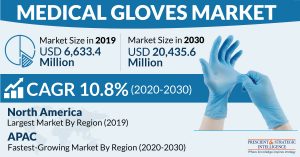As per the estimates of the World Health Organization (WHO) non-communicable diseases (NCDs) or chronic diseases account for nearly 71% of the global deaths. The WHO states that approximately 1.5 million, 4.1 million, 9.3 million, and 17.9 million deaths across the world are caused by diabetes, respiratory diseases, cancer, and cardiovascular diseases (CVDs), respectively, every year. The surging prevalence of such chronic diseases is leading to a significant surge in the number of surgeries, which, in turn, is expected to generate a huge requirement for medical gloves in the coming years.

Medical Gloves Market
Moreover, the ongoing COVID-19 pandemic will also help the medical gloves market progress at a healthy CAGR of 10.8% during 2020–2030. The market was valued at $6,633.4 million in 2019 and it is projected to generate $20,435.6 million revenue by 2030. Currently, medical professions are using protective medical items, such as surgical and examination gloves, to contain the spread of coronavirus, as it is transmitted through direct contact. Additionally, the recent outbreak of severe acute respiratory syndrome (SARS), Ebola, Zika, and Middle East respiratory syndrome (MERS) has also augmented the usage of medical gloves worldwide.
In recent years, consumers across the world have shifted from powdered medical gloves to non-powdered medical gloves, due to the non-allergic properties of the latter. Powdered medical gloves contain starch to facilitate hand movement and avoid the sticking of gloves during packaging. However, contact with starch can cause extreme allergic reactions while performing surgeries, owing to which, medical professionals are shifting toward non-powdered variants. Moreover, the increasing availability of non-powdered medical gloves at affordable prices will also steer this shift in the upcoming years.
In contemporary times, medical professionals are preferring nitrile gloves over latex, vinyl, and neoprene ones, due to their non-allergic properties. Additionally, nitrile gloves exhibit high puncture resistance and they are considered ideal for surgical and medical examination applications. Hospitals, clinics and diagnostic centers and ambulatory surgery centers (ASCs) use a wide variety of sterile and non-sterile medical gloves produced by Kimberly-Clark Corporation, Riverstone Holdings Limited, B. Braun Melsungen AG, Dynarex Corporation, Paul Hartmann AG, SHIELD Scientific B.V., and Medline Industries Inc.
